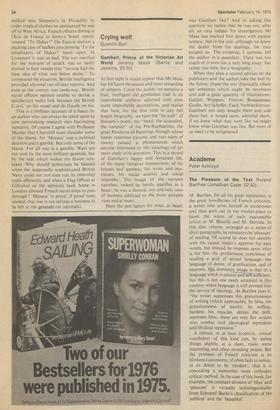Crying wolf Quentin Bell
Gambart, Prince of the Victorian Art World Jeremy Maas (Barrie and Jenkins, £8.50)
At first sight it would appear that Mr Maas has hiteivon the easiest and most rewarding of subjects. Upon the jacket, we perceive a frail, intelligent old gentleman clad in an improbable uniform adorned with even more improbable decorations, and realise that here, for the first time in any full length biography, we have the "he wolf" of Rossetti's poem, the "beast, the scoundrel, the vampire" of the Pre-Raphaelites, the great Pandarus of Paintings through whose hands countless pictures and vast sums of money passed, a phenomenon which anyone interested in the sociology of art must study with attention. This is a record of Gambart's happy and fortunate life, of his many lucrative transactions, of his houses and gardens, his wives and mistresses, his social ascents and social triumphs. The image of the vampire vanishes, indeed he barely qualifies as a beast ; he was a shrewd, not unkindly man of business addicted to the more amiable vices and at heart ...
Here the pen falters for what, at heart,
was Gambart like? And in asking this question we realise that he was not, after all, an easy subject for investigation, Mr Maas has tracked him down with patient science; but in the end, although we know the dealer from his dealings, the man escapes us. The evidence, I surmise, left the author in a quandary. There was too much of it even for a very long essay, but rather too little for a biography.
When they plan a second edition let the publishers and the author, take the bull by the horns, prune the text drastically (there are sentences which might be rewritten) and add a great quantity of illustrations: Gallait, Wappers, Troyon, Bouguereau, Gudin, Ary Scheffer, Faed, Verboeckhoven. Gambart not only bought them and sold them but, it would seem, admired them; if we knew what they were like we might know what Gambart was like. But most of us need to be enlightened.


































 Previous page
Previous page